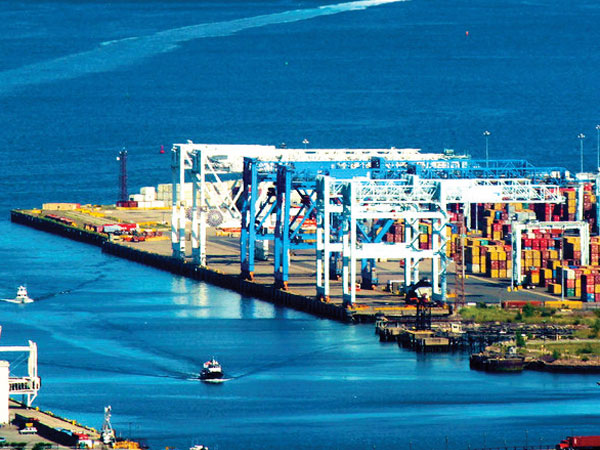Massport’s Conley Terminal had another banner year and is setting up for the future with improvements and harbor dredging.
The Port of Boston is hands down New England’s largest port, but with the Canadian ports of Montreal and Halifax to the north and northeast, and the mega-port of New York/New Jersey to the southeast not to mention a host of other East Coast ports all clamoring for ships calls, remaining the biggest duck in a regional pond is a difficult task.
Last year, Massport Board of Directors approved an $850 million investment plan for the Port. And in the recently announced fiscal year 2019-2023 comprehensive financial plan for the Authority, $405 million was inked in for Conley Container Terminal and another $52 million for Flynn Cruiseport.
Much of the money is dedicated to keeping the port competitive with its larger neighboring ports by upgrading Conley Terminal’s ability to handle larger 22-wide containerships with lower profile ship-to-shore gantry cranes. The lower profile cranes are necessary as the container terminal falls within the flight path of Logan International Airport, which lies on the East Boston side of the harbor.

Ship Calls
The Port of Boston has done very well of late. It has set container volume records in four consecutive years, with the latest record hitting just over 298,000 TEUs up 10% over 2017. This is a remarkable tally for a port besieged by container hub ports on all sides. But it also speaks to the draw that is the “Hub” or metro Boston. Because it is one of the wealthiest cities in the Northeast and similar to New York, concentrated in a relatively small footprint of under 90 sq/mi, holding nearly 700,000 full time residents and another 130,000 plus undergraduate students. With so many consumers practically on top of the port, this is a consumer market to be fed by ship calls. But to keep the boxships calling requires having terminal facilities that favorably match other ports within a vessel’s rotation. In the case of the Port of Boston, handling 12,000-14,000 TEU ships is becoming a must, especially since the expansion of the Panama Canal in 2016. Containerships operate largely on the concept of economies-of-scale which puts smaller ports like Boston at a distinct disadvantage. Ideally, the larger the vessel, the faster a block of containers can be discharged and replaced with export boxes. Conversely, if there is only a small number of boxes being discharged - picked off piecemeal - the slower and less efficient the operation. Additionally, the greater the imbalance of imports to exports, the slower the process…and time is very much money to boxship operators. Of course, there is the caveat that most carriers calling the Northeast make their money on the inbound high value side rather than with the lower value (often higher weight) exports. Historically, there have been periods where the inbound/outbound ratio approached 7/3 but the trend has been a little more even since the Great Recession. However, the combination of the tariff war has again inched imports upwards. In 2018 imports hit 147,820 TEU up 13.7% over 2017 while exports tallied 80,190 TEU down 8.4%. Empties were up over 31%, a function of higher imports and the need for container repositioning. The actual number of ships calls was down to 164 in 2018 compared to 194 in 2017, again reflecting a global trend of bigger ships but fewer port calls. Productivity has been a key calling card for the port and truck turns remain competitive – mainly in the lower 30-minute range. The lifts per hour (the boxes shifted by the gantry cranes) have also remained relatively steady at over 32 per hour – well above the Massport benchmark of 27.20.
Future Port Plans
In 2018 the port made plans for purchasing at $45 million three ship-to-shore low profile gantry cranes to facilitate the handling of the larger boxships. Additionally, there’s the two 50 foot berths being built which will allow the handling of ships with greater draft (there is a long history in the port of playing the tides to accommodate deep draft vessels). In functional terms, this means that a vessel call full laden from Asia or Europe could call Boston first inbound rather than being at the end of an outbound rotation when the vessel is lighter. Other projects underway include an expanded reefer storage area and new in-and-out gate facilities. Additionally, Massport and Columbia Intermodal have worked together to introduce 300 new chassis to the Fargo Street chassis pool.
Besides the gantry cranes, Massport also will take delivery of four Konecranes RTGs in 2019.
The cranes will be delivered to Conley Terminal in Boston, where Massport will operate a fleet of twelve Konecranes RTGs. The order was booked in 2018. The Konecranes RTGs on order are 16-wheel machines lifting 40-ton containers 1-over-5, at six container rows wide plus truck lane. They will be equipped with the Konecranes Active Load Control (ALC) system, which eliminates container sway. They will also be equipped with the Auto-steering feature.
Perhaps the most important initiative is the “Boston Harbor Dredging Project.” The project is a $350 million partnership between the U.S. Army Corps of Engineers, the Commonwealth of Massachusetts, and Massport. The project includes maintenance dredging of the inner harbor (completed in 2017) and the deepening of the main ship channels. It was announced in March that the ongoing dredging project will receive $34.8 million in 2020 for USACE Civil Works budget which takes effect in October.
An additional $500 million of planned landside infrastructure investments is also in the works supported by a $42 million U.S. DOT FASTLANE Grant and $107.5 million from the State.
Overall, the combination of investments and initiatives will provide the port with the basis to handle the current crop of boxships and to open up the possibility for more services.





